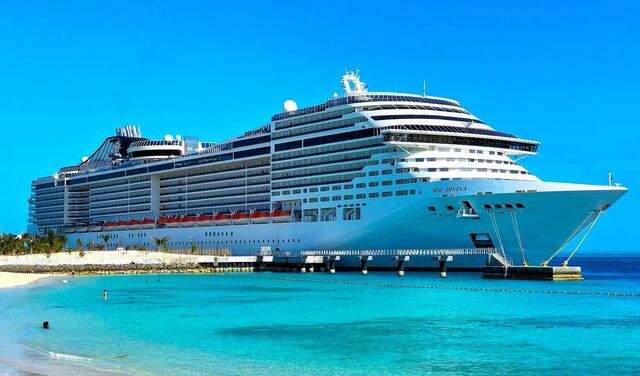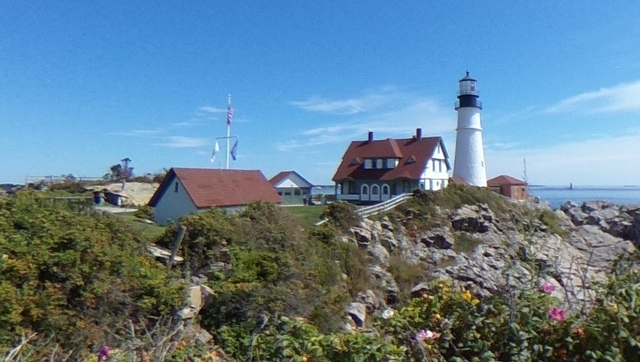The Maine Coastline Is Home To Some Beautiful Lighthouses
1. Portland Head Lighthouse
One of New England's most striking lighthouse locations is the Portland Head Light. The lighthouse was constructed during George Washington's presidency and was recently restored. It is best viewed at high tide on a windy day. The museum is located in the former keeper's quarters.
Portland Head Light is the oldest lighthouse in Maine and is one of the most photographed. It stands over 80 feet tall and has guided ships into Portland Harbor for over 230 years. Located in Cape Elizabeth, just seven miles outside of Portland, this lighthouse is still in excellent condition and features a museum and award-winning display. Whether you are visiting for the first time or are a frequent visitor, you'll be amazed at the view from this iconic landmark. Portland Head Light is also an excellent place for photography, as you can capture the lighthouse from different angles.
The Portland Head Light was powered by electricity in 1929. However, it remained dark for three years during World War II. After this period, the second-order Fresnel lens was replaced with an aerobeacon. The Portland Head Light has faced a difficult life, plagued by severe weather. In 1972, the keeper, Coast Guardsman Robert Allen, described a storm that tore the fog bell from the house and ripped an 80-foot fence off the house. Longfellow visited the Portland Head Light several times and probably got his inspiration for the poem "The Lighthouse."
2. West Quoddy Head-Light
Standing tall and straight in Passamaquoddy Bay, the West Quoddy Head Lighthouse has served as a beacon of safety for generations of mariners. It's located near the southern tip of the eastern face of the peninsula. The lighthouse is still a popular destination for visitors to this area and is open to the public for viewing.
Built-in 1808, the West Quoddy Head Lighthouse is the easternmost point in the United States. The US Coast Guard operates it. This historic landmark stands on a rocky point called West Quoddy Head. The lighthouse was initially made of local stone but was dismantled in 1857 and replaced with a 45-foot brick tower and Fresnel lens. The lighthouse is known for its distinctive red and white markings.
The lighthouse's red and white stripes stand out in the snow. These stripes were a common feature of lighthouses throughout Canada during the early nineteenth century. They were designed to help lighthouses stand out against the snow. The horizontal stripes were also used at the Assateague Lighthouse in Virginia and Sapelo Island Lighthouse in Georgia. In 1820, the lighthouse received the nation's first fog bells.
3. Monhegan Island Light
The Monhegan Island Lighthouse, located on the midcoast of Maine, is a beautiful, historic structure with panoramic views of the surrounding waters. It's another Parris-style lighthouse. The keeper's house is now home to the Monhegan Museum of Art & History, one of the state's top small museums.
The Monhegan Island Lighthouse is easily accessible via ferry from Boothbay Harbor. Initially a Second Order Fresnel lens, it was automated in the 1980s. Its operation was halted following a hurricane, but the US Coastal Guard has installed a new solar beacon. The lighthouse is the only caisson-style lighthouse open to visitors. It serves as a warning to boaters about a ledge that is dangerous. Visitors can take a guided tour during the summer.
Another lighthouse on Monhegan Island is the Pemaquid Point Light. This historic structure is featured in the Maine quarter. Pemaquid Point is a rocky outcrop that was formed by glaciers. John Quincy Adams commissioned this lighthouse in 1827 to help protect incoming ships. The lighthouse and the boardwalk connecting it were restored in the following decades. During the industrial age, the lighthouse guided ships and merchants to granite quarries, shipyards, and fish canneries.
4. Bass Harbor Light
Bass Harbor Light in Cape Neddick is one of the most picturesque lighthouses in Maine, and it's known as the "Nubble Light." The lighthouse is on a 2.5-acre island separated from the mainland by a 100-foot channel. It was first lit on July 1, 1879. Since 1987, it has been automated. The lighthouse is a popular tourist destination and offers plenty of photography opportunities.
Bass Harbor Head Lighthouse: This historic lighthouse sits high on a cliff, marking the entrance to Bass Harbor. It's located on Mount Desert Island and offers panoramic views of the ocean and the nearby Acadia National Park. The lighthouse can be reached by car or via a complimentary shuttle service.
Bass Harbor Light: Visited by thousands of people every year, Bass Harbor Light has been on the National Register of Historic Places since 1978. The lighthouse is owned and operated by the U.S. Coast Guard. Visitors can take a walk through the grounds of this lighthouse and get a bird's-eye view of the surrounding waters.
5. Cape Neddick Light
The Cape Neddick Lighthouse is a historical landmark on Cape Neddick Island, Maine. It was built in 1897 and automated in 1987. Initially, there were periods of darkness due to cold Atlantic Ocean winds. Later, however, this problem was solved when the lighthouse was electrified. The lighthouse has six rooms, each indicating one of the four directions of the compass.
This lighthouse stands on a tiny island near the York River, off Nubble Road in York Beach. The area was a site of many shipwrecks. However, one of the most infamous was the ship Isadore, which sank on Thanksgiving night in 1842. There have been many claims of seeing a phantom ship near the wreck. In any event, the wreck was one of the catalysts that led to the construction of the Cape Neddick Lighthouse.
During low tide, it was possible to walk to the lighthouse. To transport supplies and personnel, a special bucket was used. In 1884, the lighthouse was manned by two keepers. The first keeper, David Winchester, put two children in a bucket every morning. After a while, his business became so lucrative that he and his wife neglected their keepers' duties.
6. Whaleback Lighthouse
Whaleback Lighthouse is a historic lighthouse located just off the coast of Kittery, Maine. It was built between 1829 and 1830 and stands on a granite pier 42 feet in diameter. It features two fixed white lights placed at ten feet above sea level. The tower's location was chosen to distinguish it from other navigational aids.
Located in Acadia National Park, Bass Harbor Head Light is one of the eight best Maine lighthouses. This lighthouse was built by George Washington and still serves the region. It is open to the public and an excellent place to tour. When visiting, make sure to call ahead to check hours and availability.
A lighthouse is essential for mariners, who depend on it to navigate their way. If you're traveling by boat, you may be interested in seeing how a lighthouse works. There are two types of lighthouses, the classic and sparkplug types.
7. Boon Island Light
From the beaches of York and the mainland, you can see the Boon Island Lighthouse, six miles offshore. Built-in 1811 on a barren rock island, it's a constant beacon for sailors. It can be viewed up to 21 miles out at sea in clear weather.
Boon Island Lighthouse is New England's tallest, standing 133 feet high. It is so far offshore that it's visited more often by seals than people. Still, its presence on the island constantly reminds us of the dangers that lighthouse keepers once faced. The dark, lonely, and sometimes deadly conditions that these structures were built to prevent are echoed in this lighthouse's name.
While it may not be open to the public, the Boon Island lighthouse is a photogenic attraction. Its red light is especially striking, and its location is a popular destination for tourists. The lighthouse is located near Sohier Park. It is made of gray granite and stands 133 feet high.
8. Spring Point Ledge Light
The Spring Point Ledge Lighthouse is located in South Portland, Maine. It's the only caisson-style light station in the United States and is open to the public. The lighthouse is run by the nonprofit Spring Point Ledge Light Trust. You can visit the lighthouse free of charge.
The lighthouse was initially built in 1897. It was constructed after seven steamship companies reported running aground on the sand bar. The lighthouse was built with a budget of $20,000 allocated by Congress. However, the lighthouse cost nearly $45,000 due to storms and other difficulties. The lighthouse features a fog bell that sounds twice a minute and a fifth-order Fresnel lens. It was lit for the first time on May 24, 1897.
The lighthouse is located near the southern entrance of Portland harbor. It stands on the end of an 850-foot breakwater. The lighthouse is open to the public and provides a unique experience to learn more about lighthouses and the harbor's history.




